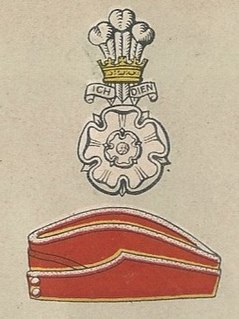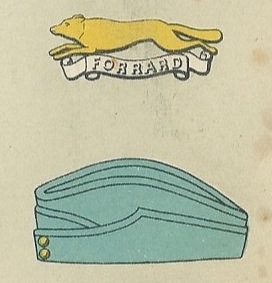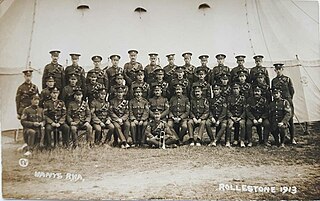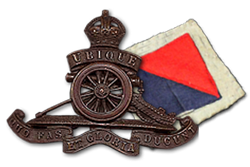
Beilby Lawley, 3rd Baron Wenlock was a British soldier, Liberal politician and colonial administrator who was the Governor of Madras from 1891 to 1896.

The Norfolk Yeomanry was a volunteer cavalry (Yeomanry) regiment of Britain's Territorial Army accepted onto the establishment of the British Army in 1794. After seeing action in the Second Boer War, it served dismounted at Gallipoli, in Palestine and on the Western Front during the First World War. Between the wars it converted to the Royal Artillery (TA), and served as an anti-tank regiment in France, the Western Desert, Italy and North West Europe during the Second World War. After the war it served as a TA air defence unit and then as an Army Air Corps unit.

The Northumberland Hussars was a Yeomanry regiment of the British Army, transferred to the Royal Artillery for the duration of the Second World War. It was disbanded as an independent Territorial Army unit in 1967, a time when the strength of the Territorial Army was greatly reduced. The regiment's name lives on in the title of the command and support squadron of the Queen's Own Yeomanry (QOY), a Formation Reconnaissance Regiment based in Newcastle upon Tyne.

The Yorkshire Hussars was an auxiliary unit of the British Army formed in 1794. The regiment was formed as volunteer cavalry (Yeomanry) in 1794 during the French Revolutionary Wars and served in the Second Boer War and the First World War. It was converted to an armoured role during the Second World War. In 1956, it merged with two other Yorkshire yeomanry regiments to form the Queen's Own Yorkshire Yeomanry. Its lineage is continued today by the Queen's Own Yeomanry.

The East Riding of Yorkshire Yeomanry was a unit of the British Army formed in 1902. Units of Yeomanry Cavalry were raised in the East Riding of Yorkshire in the 18th and early 19th centuries at times of national emergency: the Jacobite Rising of 1745, the French Revolutionary Wars and the Napoleonic Wars. These were stood down once each emergency was over. The East Riding of Yorkshire Yeomanry, was established in 1902, and this saw action during the First World War both in the mounted role and as machine gunners.

The Westmorland and Cumberland Yeomanry was a Yeomanry Cavalry regiment of the British Army with its origins in 1798. The regiment provided troops for the Imperial Yeomanry during the Second Boer War and served on the Western Front in World War I, latterly as infantry. The regiment converted to artillery in 1920 and served as such in the early years of World War II, before becoming part of the Chindits in Burma. Postwar it served as a gunner regiment until 1971 when the title disappeared.
205 is part of the 101st (Northumbrian) Regiment Royal Artillery and is equipped with the M270 Multiple Launch Rocket System. It is based in South Shields, United Kingdom.
In September 1939, the British Army was in process of expanding their anti-aircraft and mobile assets. Among these new changes was the formation of Anti-Aircraft Command which was formed on 1 April 1939, and the 1st Armoured Division formed in 1937. The list below will include the British Army units, colonial units, and those units which were in the process of formation.
The Yorkshire Mounted Brigade was a formation of Britain's part-time Territorial Force organised in 1908. Mobilised on the outbreak of World War I, its regiments had been posted away by 1915 so it was broken up. It never saw active service.

The Hampshire Royal Horse Artillery was a Territorial Force Royal Horse Artillery battery that was formed in Hampshire in 1909. It saw active service during the First World War in Egypt and Palestine from 1916 to 1918, initially as field artillery with 52nd (Lowland) Division before being converted back to horse artillery and serving with the Yeomanry Mounted Division and 1st Mounted / 4th Cavalry Division. A second line battery, 2/1st Hampshire RHA, served on the Western Front in 1917 and 1918 as part of an Army Field Artillery Brigade. Post-war, it was reconstituted as a Royal Field Artillery battery.

The East Riding (Fortress) Royal Engineers was a volunteer unit of Britain's Royal Engineers formed for the defence of the Humber Estuary in the East Riding of Yorkshire. As well as serving in this role it also provided field and specialist engineer units in both World Wars. Its successors continued to serve in the Territorial Army until 1991.

The 10th Anti-Aircraft Division was an air defence formation of the British Army during the early years of the Second World War. It defended Yorkshire and Northern Lincolnshire during The Blitz and the Baedeker Blitz but only had a short career.

Londesborough Barracks is a military installation in Kingston upon Hull, England.
The 1st North Riding Artillery Volunteers was a part-time unit formed in the North Riding of Yorkshire in 1860 in response to an invasion scare. The unit later became part of the Territorial Force and served on the Western Front during World War I, while their successors served as anti-aircraft gunners in World War II.
The 2nd East Riding Artillery Volunteers was a part-time unit of Britain's Royal Artillery based at Hull and along the Humber Estuary. Its successor units provided field artillery on the Western Front during World War I and air defence artillery during and after World War II. Latterly it formed part of the Humber Artillery based at Hull.

The West Riding Heavy Battery, Royal Garrison Artillery was a part-time unit of Britain's Territorial Force formed in 1908 in the West Riding of Yorkshire. It fought on the Western Front during World War I, and served on in the Territorial Army until the eve of World War II.

85th (Tees) Heavy Anti-Aircraft Regiment, Royal Artillery was a part-time unit of Britain's Territorial Army (TA) formed from forces around the river Tees just before the outbreak of World War II. Its service during the war included the Battle of France and Dunkirk evacuation, the Battle of Britain and Blitz, and the North African and Italian campaigns. It continued to serve in the air defence role until 1961.

91st Heavy Anti-Aircraft Regiment, Royal Artillery was a part-time unit of Britain's Territorial Army (TA) formed in the West Riding of Yorkshire just before the outbreak of World War II. Its service during the war included Home Defence during the Battle of Britain and The Blitz, and a length period in Middle East Forces. Postwar it continued to serve in the TA in the air defence role until 1955.

The East Riding Royal Garrison Artillery (ERRGA) was a part-time unit of Britain's Royal Artillery based at Hull in the East Riding of Yorkshire. It provided coastal defence artillery along the Humber Estuary from 1908 to 1956, manned siege batteries on the Western Front during World War I at the Somme and Ypres and played a role in the pursuit of the German army during the Hundred Days Offensive. It served as infantry in Allied-occupied Germany after World War II. Its successor units in the Territorial Army included anti-aircraft artillery and field engineers.

The 5th (Cyclist) Battalion, East Yorkshire Regiment was a mobile coast defence unit of Britain's Territorial Force. It was formed in 1908 from a nucleus provided by a Volunteer battalion first raised in 1859. It carried out its defence duties along the East Coast throughout World War I and after the war it was incorporated into a unit of the new Royal Corps of Signals.














